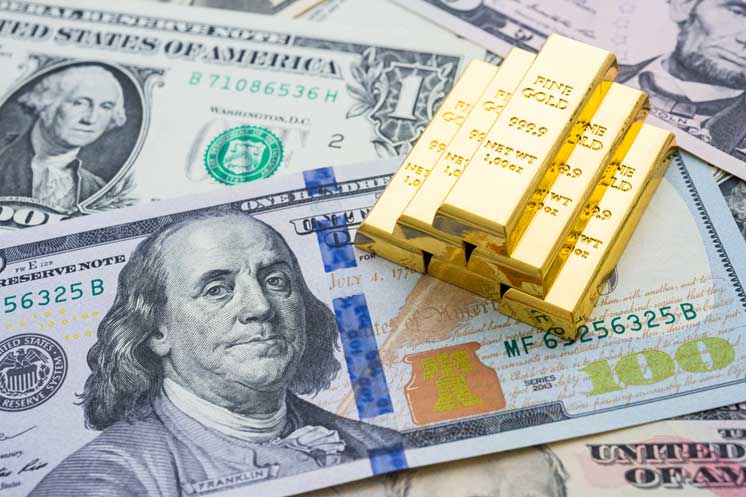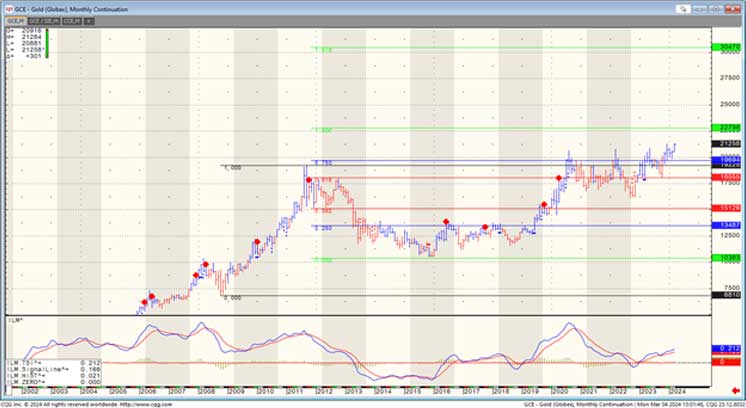The investment landscape surrounding gold, whether through physical bullion or futures contracts, has been a topic of increasing interest, especially with the current dynamics of the global economy, inflationary pressures, and the rise of digital currencies like Bitcoin. As of March 4th, 2024, gold futures are trading at $2,125 per ounce, just shy of the all-time high of $2,130. This positions gold futures at a critical juncture, prompting investors to contemplate the next move in this precious metal’s market. The speculation that gold futures could reach $3,000 reflects not just optimism but also a series of underlying economic concerns and trends that merit a closer examination.

Gold Bullion vs. Gold Futures: A Comparative Analysis
Gold Bullion: The Traditional Safe Haven
Gold bullion has been the quintessential store of value for centuries. Its physical tangibility, intrinsic value, and historical role as a medium of exchange lend it a unique position in the investment world.
Monthly Chart of Gold Futures for March 2024

Advantages:
- Tangible Asset: Gold bullion provides a physical asset that investors can hold, offering a psychological comfort level.
- No Default Risk: Unlike financial assets, gold bullion carries no risk of default, making it a safe haven in times of economic uncertainty.
- Inflation Hedge: Historically, gold has maintained its value over the long term, serving as an effective hedge against inflation.
Disadvantages:
- Storage and Security Costs: Physical gold requires secure storage, which can incur significant costs and logistical challenges.
- Illiquidity and Transaction Costs: Buying and selling physical gold can come with higher transaction costs and liquidity issues compared to financial assets.
- No Passive Income: Gold bullion does not generate any income, such as dividends or interest, for its holder.
Gold Futures: The Financial Instrument
Gold futures are contracts to buy or sell a specific amount of gold at a predetermined price on a future date. These contracts are traded on futures exchanges and offer different benefits and risks compared to physical gold.
Advantages:
- Leverage: Futures contracts allow investors to control a large amount of gold with a relatively small amount of capital upfront.
- Liquidity: The futures market offers high liquidity, enabling investors to easily enter and exit positions.
- Hedging Opportunities: Investors can use gold futures to hedge against market volatility and protect against adverse movements in the price of gold.
Disadvantages:
- Complexity and Risk: Futures contracts can be complex and carry a high level of risk, potentially leading to significant losses.
- Margin Calls: Investors may face margin calls if the market moves against their position, requiring additional capital to maintain the position.
- Potential for Contango: In futures markets, when future prices are higher than spot prices (contango), rolling over contracts can erode profits for long-term investors.
Hedging Gold Bullion Holdings with Gold Futures
For investors holding physical gold, gold futures offer a sophisticated method to hedge against price volatility. By selling gold futures contracts, an investor can lock in a future price for their gold. If the market price falls, the gains from the futures contracts can offset the loss in value of the physical gold. This strategy requires a keen understanding of futures markets and precise timing to ensure the hedge effectively matches the exposure of the physical holdings.
The $3,000 Projection
The projection that gold futures could reach $3,000 per ounce is ambitious, underpinned by several macroeconomic factors:
- Inflation: Persistent high inflation could erode the value of fiat currencies, making gold an attractive store of value.
- Economic Uncertainty: Geopolitical tensions, economic sanctions, and global debt levels can increase demand for gold as a safe haven.
- Dollar Weakness: The gold price is inversely related to the strength of the US dollar. A weakening dollar makes gold cheaper for holders of other currencies, potentially increasing demand.
- Digital Currencies: The rise of Bitcoin and other cryptocurrencies as “digital gold” could influence gold prices. While some see them as competitors, others view the rise in digital currencies as an indicator of gold’s lasting value in a digital age.
However, reaching a $3,000 price point would require a significant confluence of these factors, along with sustained investor interest and market dynamics favoring commodities. Additionally, the role of central bank policies, particularly in terms of interest rates and monetary expansion, would be crucial in this scenario.
Bitcoin, Inflation, and Gold Futures
Bitcoin’s approach to its all-time high reflects a broader search among investors for assets that can serve as a hedge against inflation and currency devaluation. While Bitcoin and gold share certain safe-haven characteristics, their markets operate differently. Bitcoin’s volatility and digital nature contrast with gold’s physicality and historical stability. The relationship between Bitcoin prices and gold futures is complex, with each appealing to different segments of the investor population.
Looking Ahead: The Path for Gold Futures
With gold futures near their all-time high and speculation about future price movements, investors are closely monitoring the economic indicators that could influence gold’s trajectory. While the $3,000 projection for gold futures is speculative, it underscores the broader interest in gold as a hedge against uncertainty and inflation.
In navigating the path ahead, investors would do well to consider the diverse factors that influence gold prices, including global economic trends, monetary policies, and the evolving landscape of digital currencies. The historical resilience of gold, combined with the strategic use of gold futures, continues to make it a cornerstone of diversified investment portfolios.
In conclusion, whether gold futures can reach the $3,000 mark remains speculative, hinged on multiple macroeconomic variables and investor sentiment. Nonetheless, the fundamental qualities that make gold an enduring investment—its ability to hedge against inflation, economic uncertainty, and currency devaluation—remain as relevant as ever. As we navigate an increasingly complex financial landscape, the timeless allure of gold, whether in bullion or futures form, continues to hold a pivotal place in investment strategies aimed at wealth preservation and risk management.
Ready to start trading futures? Call US 1(800)454-9572 – Int’l (310)859-9572 email info@cannontrading.com and speak to one of our experienced, Series-3 licensed futures brokers and start your futures trading journey with E-Futures.com today.
Disclaimer – Trading Futures, Options on Futures, and retail off-exchange foreign currency transactions involves substantial risk of loss and is not suitable for all investors. Past performance is not indicative of future results. You should carefully consider whether trading is suitable for you in light of your circumstances, knowledge, and financial resources. You may lose all or more of your initial investment. Opinions, market data, and recommendations are subject to change at any time.
**This article has been generated with the help of AI Technology. It has been modified from the original draft for accuracy and compliance.
***@cannontrading on all socials.




